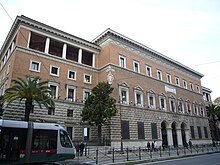Ministry of Justice (Italy)
The Italian Ministry of Justice ( Italian: Ministero della Giustizia ) is a ministry of the Italian government . It is located in the near the Tiber Island located Palazzo Piacentini in Rome . Acting Minister of Justice and keeper of the seal is Alfonso Bonafede .
tasks
The Ministry of Justice is responsible for matters of civil and criminal law , for the administration of justice and the organization of the judiciary and the public prosecutor's office as well as for the penitentiary system and the grace system . It also handles intergovernmental matters relating to the administration of justice and examines other legal issues, insofar as this is not carried out by other authorities.
Italian judges and prosecutors are independent in the exercise of their duties and are not subordinate to the Ministry of Justice, but to their self-governing body Consiglio Superiore della Magistratura . However, the Minister of Justice may, under certain conditions, initiate disciplinary proceedings or investigations against them .
The Ministry is not responsible for administrative , financial and military courts . Organizationally, they are subordinate to the Prime Minister , the Ministry of Finance and the Ministry of Defense . In these cases, too, the respective judges are independent in the exercise of their office and are only subordinate to their respective self-governing body.
Central organization
The political leadership consists of the minister and usually two state secretaries . The latter are not civil servants in Italy, but politicians. In contrast to some other ministries, the departments (“General Directorates” ) are grouped into main departments ( Dipartimenti ). Ministries without main departments have a general secretary as head of office ; it doesn't exist here. The corresponding tasks are taken over by the heads of the main departments.
- Department of Justice ( Dipartimento per gli Affari di Giustizia ) (3 departments)
- Main Department for the Organization of Justice, Human Resources and Services ( Dipartimento dell'Organizzazione Giudiziaria, del Personale e dei Servizi ) (6 departments)
- Main Department for Juvenile Justice ( Dipartimento per la Giustizia Minorile ) (2 departments)
- Penitentiary Administration Department ( Dipartimento dell'Amministrazione Penitenziaria ) (3 departments)
The Police Office Penitenziaria is subordinate to the Main Penitentiary Department .
Subordinate institutions
The main department for the organization of justice and its three regional directorates in Milan , Rome and Naples are organizationally subordinate to:
- the Supreme Court of Cassation
- the General Prosecutor's Office and the National Anti-Mafia Prosecutor's Office at the Court of Cassation
- 26 appellate courts (with 3 branches) with associated public prosecutor's offices and anti-mafia public prosecutor's offices
- 26 juvenile courts (with 3 branches) with associated public prosecutor's offices
- 136 regional courts with associated public prosecutor's offices (+4 regional courts in Abruzzo, which will close in 2018)
- around 350 peace courts (as of 2015)
- 8 regional courts and a supreme court for public waters
- Main article: List of dishes in Italy
In 2012, the Monti government decided to rationalize the courts and their administrative districts, which was implemented by 2014. Of the last 165 regional courts and 220 branches, 30 courts and all branches were closed. Of the 848 peace courts, 667 were to be dissolved, but the local authorities were ultimately free to continue operating peace courts at their own expense.
The Department for Juvenile Justice are subject to juvenile detention centers and various social services and facilities. The main department for penal administration is subordinate to 11 regional directorates with subordinate penal institutions of various categories.
history
The history of the Italian Ministry of Justice can be traced back to the Grand Chancellor and keeper of the seal of the Duchy of Savoy . From his office in 1848 the "Ministry for Church, Mercy and Justice Matters" ( Ministero per gli affari Ecclesiastici, di Grazia e di Giustizia ) of the Kingdom of Sardinia-Piedmont emerged. From 1848 this kingdom was at the forefront of the Italian unification movement , into which the old Italian states were incorporated in 1861 and which thus took on the name Kingdom of Italy .
The Piedmontese Ministry of Justice in Turin thus became Italian in 1861 and extended its territorial jurisdiction to the entire new state. It came to Florence in 1865, then to Rome in 1871 . In 1922, the Ministry was given responsibility for the penal system, which had previously been with the Ministry of the Interior. In return, the latter was given responsibility for church and religious affairs ten years later. From 1932 to 1999 the ministry was officially called the “Ministry of Grace and Justice” ( Ministero di Grazia e Giustizia ), then it was given its current name in the course of far-reaching organizational reforms.
Web links
Individual evidence
- ↑ Legislative Decree 7 September 2012, n. 155 on ordavvsa.it The Urbino Regional Court remained in existence after the Constitutional Court's judgment 237/2013 (because it was the provincial capital of Pesaro), the Giugliano Regional Court in Campania (North Naples) was reactivated in Aversa.
- ↑ Circoscrizione Giudiziaria on momentolegislativo.it ( Memento of the original from April 9, 2016 in the Internet Archive ) Info: The archive link was inserted automatically and has not yet been checked. Please check the original and archive link according to the instructions and then remove this notice.
Coordinates: 41 ° 53 ′ 32.6 " N , 12 ° 28 ′ 29.3" E



